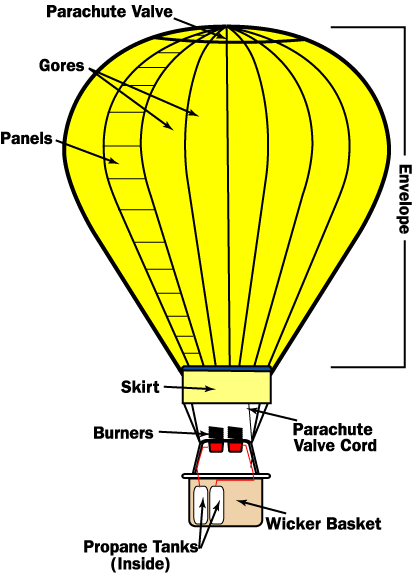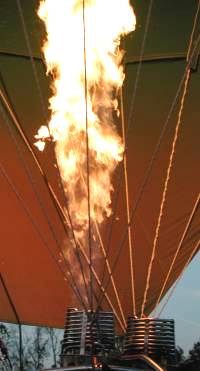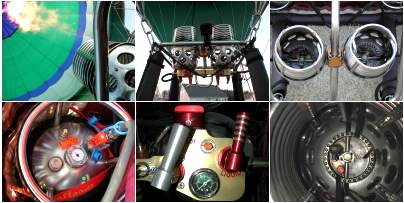|
Hot air balloons are based on a very basic scientific principle: warmer air rises in cooler air. Essentially, hot air is lighter than cool air, because it has less mass per unit of volume. A cubic foot of air weighs roughly 28 grams (about an ounce). If you heat that air by 100 degrees F, it weighs about 7 grams less. Therefore, each cubic foot of air contained in a hot air balloon can lift about 7 grams. That's not much, and this is why hot air balloons are so huge -- To lift 1,000 pounds, you need about 65,000 cubic feet of hot air! To find out exactly how this works, skip to Air Pressure + Gravity = Buoyancy.
To keep the balloon rising, you need a way to reheat the air. Hot air balloons do this with a burner positioned under an open balloon envelope. As the air in the balloon cools, the pilot can reheat it by firing the burner.

A hot air balloon has three essential parts: the burner, which heats the air; the balloon envelope, which holds the air; and the basket, which carries the passengers. |
Modern hot air balloons heat the air by burning propane, the same substance commonly used in outdoor cooking grills. The propane is stored in compressed liquid form, in lightweight cylinders positioned in the balloon basket. The intake hose runs down to the bottom of the cylinder, so it can draw the liquid out.

The burner flame heats the air in the balloon envelope. |
Because the propane is highly compressed in the cylinders, it flows quickly through the hoses to the heating coil. The heating coil is simply a length of steel tubing arranged in a coil around the burner. When the balloonist starts up the burner, the propane flows out in liquid form and is ignited by a pilot light. As the flame burns, it heats up the metal in the surrounding tubing. When the tubing becomes hot, it heats the propane flowing through it. This changes the propane from a liquid to a gas, before it is ignited. This gas makes for a more powerful flame and more efficient fuel consumption.
In most modern hot air balloons, the envelope is constructed from long nylon gores, reinforced with sewn-in webbing. The gores, which extend from the base of the envelope to the crown, comprise of a number of smaller panels. Nylon works very well in balloons because it is lightweight, but it is also fairly sturdy and has a high melting temperature. The skirt, the nylon at the base of the envelope, is coated with special fire-resistant material, to keep the flame from igniting the balloon.

Click on the burner components to see a high-resolution picture. |
The hot air won't escape from the hole at the bottom of the envelope because buoyancy keeps it moving up. If the pilot continually fires the fuel jets, the balloon will continue to rise. There is an upper altitude limit, however, since eventually the air becomes so thin that the buoyant force is too weak to lift the balloon. The buoyant force is equal to the weight of air displaced by the balloon, so a larger balloon envelope will generally have a higher upper altitude limit than a smaller balloon.

The basket holds the passengers, propane tanks and navigation equipment. | |



